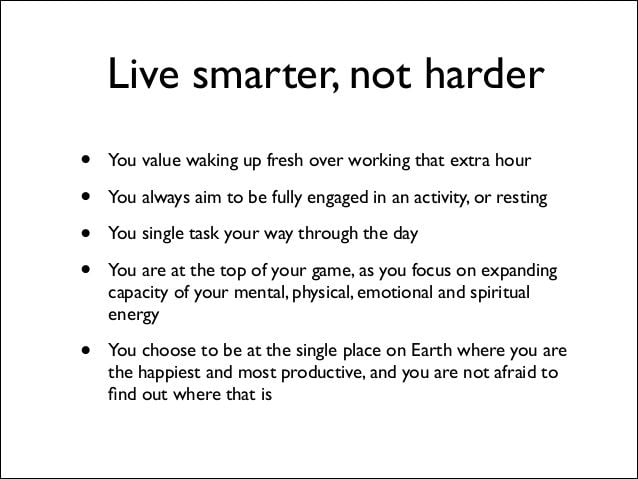
How Much Do You Work Without Set Hours? A Buffer Case Study
Former Director of People @ Buffer
Optimizing one’s day for maximum productivity—and creativity!—is one of our favorite topics to research and think over.
We’ve written on the blog before about morning routines, creativity routines, the routines of successful entrepreneurs and even ways to maximize your lunch break.
But we haven’t managed to share any of our own daily routines, until now.
Recently we were honored to be asked by the team at inbound.org to do an “Ask Me Anything” session, answering questions from their smart community. One of the most popular topics was how we work, and how many hours we work, without any rules around our work schedules.
This seemed like a great topic to share transparently about on the blog! Read on to discover more about why we offer this freedom, learn how many hours we really work at Buffer and take a peek into some teammates’ daily schedules.

We have the freedom to work how we want
Buffer is a bit unique in that, as a self-managed and distributed team with members all around the world, it doesn’t really provide any benefit to us to have everyone to work the same hours.
And seeing as one of our company values is “live smarter, not harder,” each of us gets the privilege of determining our own optimal work schedule and routine in the place where we feel happiest.

We don’t have a fixed amount of working hours, and you’re even free to experiment with your weekly schedule.
My hypothesis and data gathering
After reading a reflection from Leo on self-management, I had a theory that we at Buffer were perhaps working fewer hours than most traditional companies, especially after we became self-managed.
Our emphasis on taking breaks, getting plenty of sleep and managing energy instead of time seemed to point in that direction, and reading this from Leo made a lot of sense to me:
“I also believe that through this, self-managed companies (and Buffer, in this example) can work less to get more done. My estimation is that a self-managed team only has to work 6 hours a day to get the work done that normal companies do in 8 or 10 hours a day. Since self-managed orgs have no “zombie meetings” or bloated processes, they can operate more efficiently and create the same results in much less time.”
To find out if my hunch was correct, I sent around a voluntary internal survey to see if I could get a better understanding of how much we’re really working at Buffer.
I asked my teammates a few specific things:
- How many hours per day they worked, on average
- How many hours per week they worked, on average
- How often they worked on weekends
- If they had noticed any change in their work schedule since Buffer became a self-managed team
I got 11 responses to the voluntary survey, so a little more than 1/3 of the team participated.
The results: We work 8.27 hours a day
Checking out the results from the team was fascinating. My hypothesis did not hold up very well and I discovered that we work quite a bit at Buffer—pretty much the same amount as a “traditional” company.
A few quick stats:
- Our average work day is 8.27 hours.
- Our average work week is 43. 4 hours. (I calculated this by using the middle of the ranges teammates could choose)
- We pretty much all work on the weekends at least sometimes.
- Self-management is mostly not changing our time at work so far. (These are the answers to the question about “going Teal,” which we borrowed from the book Reinventing Organizations as our shorthand for evolved self-management)

For comparison’s sake, the average American works 8.8 hours every day and an average of 47 hours per week, so we’re just a bit under that average.
I added a spot where anyone could add some extra thoughts about their work schedule, and here are the comments from that:
- “Transitioning to Buffer, I saw my two hour commute disappear. It was surprising how much more energy has returned to my day as a result. This helps when managing my energy as I approach different tasks and float between Buffer and family.”
- “I tend to work during evenings and weekends in a very different way from “business hours” during the week. A little bit more relaxed and mixed in with other bits of personal admin perhaps. Really enjoy the time on Sundays when I jump in and get some things done ahead of next week :D Happier in this routine than I ever was when I worked 8-5 every day in the corporate world.”
- “I feel like overall I work a lot less because my role prior to going teal was managing many meetings and then finding times to focus. Now most of time is spent focusing on various areas which allows me to work fewer hours generally to feel productive.”
- “My day is very flexible. I sometimes work early in the day, take a long lunch break and work a bit later in the evening. Or perhaps sleep in a bit, then later catch an awesome sunset and jump on a few calls after dinner.”
- “It goes in waves. I’ve worked much more in March than February or January. Some months are more intense than others!”
- “I have found that I can work less by getting on with whatever I am doing whilst using the advice process to guide me :) I feel empowered to jump into an investigation or task without having to jump through hoops and by bouncing ideas off the team, I never feel lost.”
A look at 6 different teammates’ schedules
A few Buffer teammates were kind enough to volunteer even more information about their daily work routines. Here’s a detailed look at six different types of workdays across many different roles at Buffer.
Patrik, User Researcher

This was a key challenge for me when I first joined Buffer, as I found it surprisingly hard to “unlearn” hourly time-keeping. At first I used a tool called RescueTime, which tracked the time I spent on each website and total time spent each day. This gave me a great granular view of where I was spending my time, which I found really helpful during my bootcamp to keep myself on-task as I adjusted to this new method of working.
A few months in I stopped using RescueTime, and now I rely entirely on my intuition to sense if I’m striking the right balance. With our self-managing structure, we’re building a really interesting network of commitments that also help to keep me on track with the tasks that I’ve promised to do. I think the amount of variability in my schedule would be quite difficult to maintain otherwise, as I sometimes will work very long days talking with customers in different time zones, and other times I’ll take Monday afternoon off to go see a movie.
Tom, Android Developer

Each week I’ll define a set of Android or development-related goals I want to achieve. It’s usually a list of roughly 4-6 items, depending on their perceived scope. This allows me to check off things as I complete them, which is super satisfying, and also gives me a nice go-to list of things I can get done in (approximately) x hours.
The beauty of working the way we do means that I’m not necessarily worried about actually completing all the tasks I give myself in a week. If I’ve been productive, then I don’t worry about the actual tasks completed (within reason, of course). It can be a bit tough to wrap your head around, but it’s quite liberating.
Each day I’ll usually start around 8 or 9, and finish up around 5-7, depending on where I am in a task. Personally, I’ve found that each day tends to have a naturally comfortable stopping point. That might be when your brain is calling it quits, or a nice, atomic piece of functionality or bug fix is in place and initial tests look good.
I rely on my intuition a lot as for when calling it a day feels good, my best days are when I feel like I’ve been really productive, usually deep in code with successful or substantial changes. But I have also found that often, even when I don’t feel productive it doesn’t mean that I haven’t been productive!
Nicole, Community Champion

I like to get to the computer before 8 a.m. and take a few “outdoor” breaks throughout the day, whether that is visiting with the chickens outside, taking a riding lesson or running some errands. My days typically end around 6 p.m., though I’ve been known to sneak in some card-writing and swag packaging in the evening and weekend hours. (It’s too much fun!)
I tend to utilize “theme days” throughout the week to focus on the different aspects of Buffer community. Here are my general focuses for the day, though the themes do ebb and flow each week:
Monday: General tasks, email catch-up, map out the week, Mastermind :)
Tuesday: prep, some cards and packages
Wednesday: All about #bufferchat: promotion, tweeting, recapping, planning for the next week.
Thursday: Hiring inbox and sync day
Friday: #bufferloveday: cards, packages
I live by my Evernote Moleskine planner and keep all my weekly tasks in there. :)
Dan, Front-End Developer

Not much of a routine guy so my day usually starts with waking up somewhere between 8 and 9. I’m a late riser and I set 3 alarms in the morning and wake up when I feel refreshed (or if I have a meeting!).
I do a bit of email reading at home then I aim to walk over to my co-working space and sit down to work between 9:30 and 10 am. My mornings usually are email and catching up with the goings on in Europe (they get so much done while I’m asleep!!).
I mostly write code and do focus work in afternoon when I feel the most productive. Most days I end up leaving the co-working space anywhere between 6:30 and 8 pm depending if I have a meeting with people on the west coast or if I have an event to get to like a meetup or plans with friends.
As far as planning goes, I usually have some rough daily goals I keep in Evernote, but nothing too set in stone as higher priority items like bugs or small tasks can often arise. The most important aspect is communication across our various channels: the asynchronous (email), the long-running (Hackpad) and the real-time conversation (HipChat). For myself, focusing on quality communication is paramount to working without a fixed schedule. That and sending each other GIFs.
Kevan, Content Crafter

In general, I have a pretty smooth split between two different types of days: 1) where I’m spending a lot of time with my son as I’m the main person around the house, and 2) when someone is here to spend the morning with him. I do three days of each for the week, Monday thru Saturday.
Batch day
- 5:30am: Up for the day
- 5:30 to 7:30 a.m.: Focused work, final edits for the day’s blog posts, big tasks for the day
- 7:30 to noon: Play with my son, breakfast, lunch, errands, stay near Hipchat if anyone pings me, any scheduled syncs as needed
- noon to 2 p.m.: Work while my son naps, syncs and pair calls and hipchat chats, catchup on email
- 2 to 3 p.m.: Play with my son
- 3 to 5 p.m.: Work, syncs and calls, focused work on bigger tasks
- 5 to 7 p.m.: Dinner with family, play time, bed time
- 7 to 9 p.m.: Focused work, wrapping up tasks that were yet to be completed
- 9 to 10 p.m.: Relax & unwind
Focus day
- 5:30 a.m.: Up for the day
- 5:30 to 2 p.m.: Focused block of work with breaks for breakfast/morning routine and lunch, lots of writing time on these days, as well as longer syncs like masterminds and advice sessions
- 2 to 7 p.m.: Play, dinner, bed (plus any scheduled syncs or things that come up via hipchat)
- 7 to 8 p.m.: Check in with email and the goings-on of the afternoon
- 8 to 10p.m.: Relax & unwind
I’ve been trying out a weekly to-do list (vs a daily one) by storing all the week’s activities on a Trello board. It’s been helpful to see my main tasks for the week and to feel prepared for what activities to tackle next (there’s a “pending” column also for when I happen to finish all the week’s activities early!)
Philippe, Back-End Developer
My schedule is quite regular but flexible too as sometimes I enjoy spending more time at lunch discussing with friends on a sunny day :) But usually, I spend 1hour in the morning to answer emails, hackpads and discourses (2h on Mondays as there are usually more to answer). I then take 15min to list what I want to get done today, both personal and work related. It helps me to have a big picture of my day and I can better schedule sync with others if needed.
I also know I will spent 1h to 1h30 for my crossfit session (3 days a week) or home sport session (the other days). The rest of my day is shared between syncs and data/development tasks. Before signing off I check a last time my emails and see I something important need to be answered :)
Now, it is more a tweaking phase. I know how to mainly “schedule” my day but I still want to be flexible depending on “social” events. For instance, as summer is coming I want to try to get up earlier and stop working earlier to enjoy some kitesurfing sessions with friends after they end their work day :)
Over to you! Share your day
It was really fascinating to dive into our work days a bit and learn more about my teammates’ habits and routines.
I’d love to hear about your day as well! Do you have a routine or keep it loose? How many hours a day and week do you work? Share anything you’d like about your work habits in the comments!
Try Buffer for free
140,000+ small businesses like yours use Buffer to build their brand on social media every month
Get started nowRelated Articles

In this article, the Buffer Content team shares exactly how and where we use AI in our work.

With so many years of being remote, we’ve experimented with communication a lot. One conversation that often comes up for remote companies is asynchronous (async) communication. Async just means that a discussion happens when it is convenient for participants. For example, if I record a Loom video for a teammate in another time zone, they can watch it when they’re online — this is async communication at its best. Some remote companies are async first. A few are even fully async with no live ca

Like many others, I read and reply to hundreds of emails every week and I have for years. And as with anything — some emails are so much better than others. Some emails truly stand out because the person took time to research, or they shared their request quickly. There are a lot of things that can take an email from good to great, and in this post, we’re going to get into them. What’s in this post: * The best tools for email * What to say instead of “Let me know if you have any questions” a